Project Series
An Estate Stables and Woodland Barn
Written by Jonathan Lees RIBA.
By now you have likely read a couple of the other musings relating to our Arts and Crafts home in Oxfordshire, so you will be aware that the stables and woodland barn developments on this site were designed at the same time, and as part of the ensemble, as the main house and gardens.
The Stables were originally designed as part of the Summerhouse arrangement to the East of the main house and were intended to be a simple set of timber structures to provide storage for garden and household equipment. The fact that we called them stables was merely a pretention and to have some fun. There was no way that a horse was ever going to get into the buildings, and if they would have done, they would have no doubt chewed through all of the oak detailing that we included.
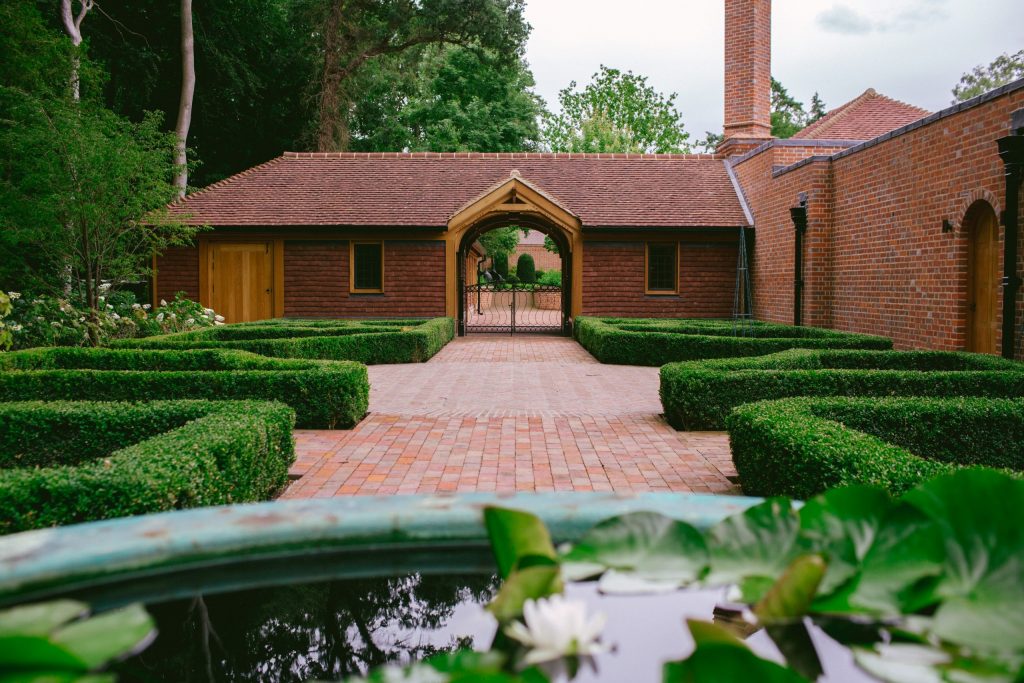
North Elevation of the Stables block
‘We were encouraged, both by my ambition and by the client letting us loose once again on the design.’
What started as a modest structure of timber clad buildings, very quickly developed into something far more detailed. We were encouraged, both by my ambition and by the client letting us loose once again on the design. In order to provide what I believe is the vital link between structures, I designed something that used the same pallet of materials used on the main house but took on a character of its own. The buildings had to remain subservient in nature to the main house, and the architectural languagefelt right to be vernacular in style, rather than overtly Arts & Crafts or classically inspired. In essence, we needed to dumb it down, but this was proving very difficult on a site where we were constantly trying to out-do ourselves, and to push the boundaries of creativity. We turned once again to engineered oak for our main inspiration. I designed a principal oak frame that was relatively simple in nature but included a charming cartway to its centre.
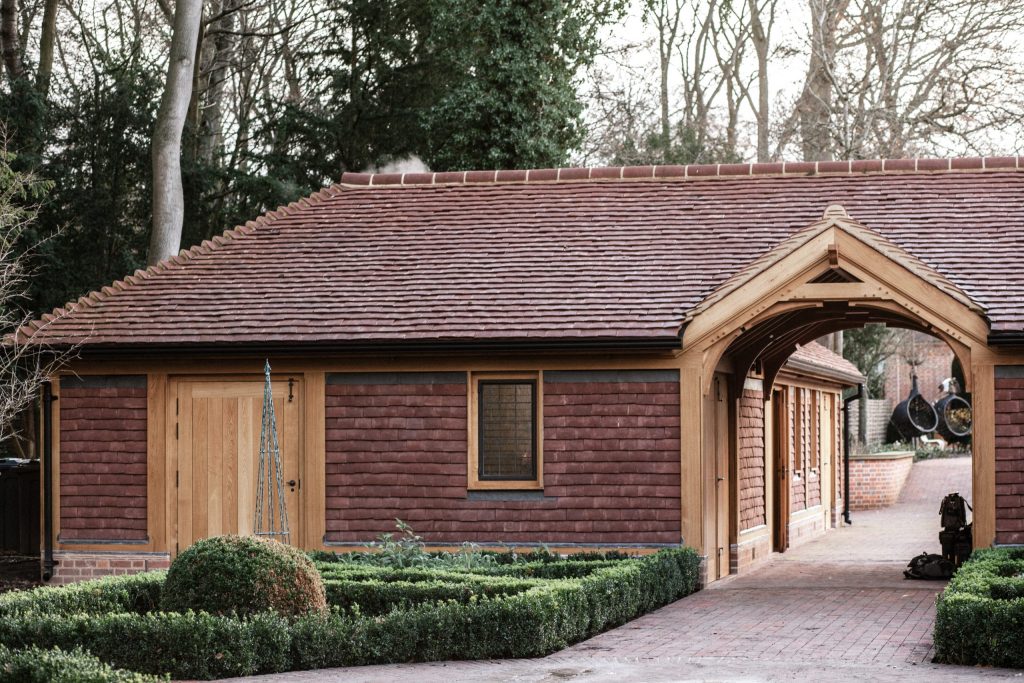
A view through the Oak-framed cartway
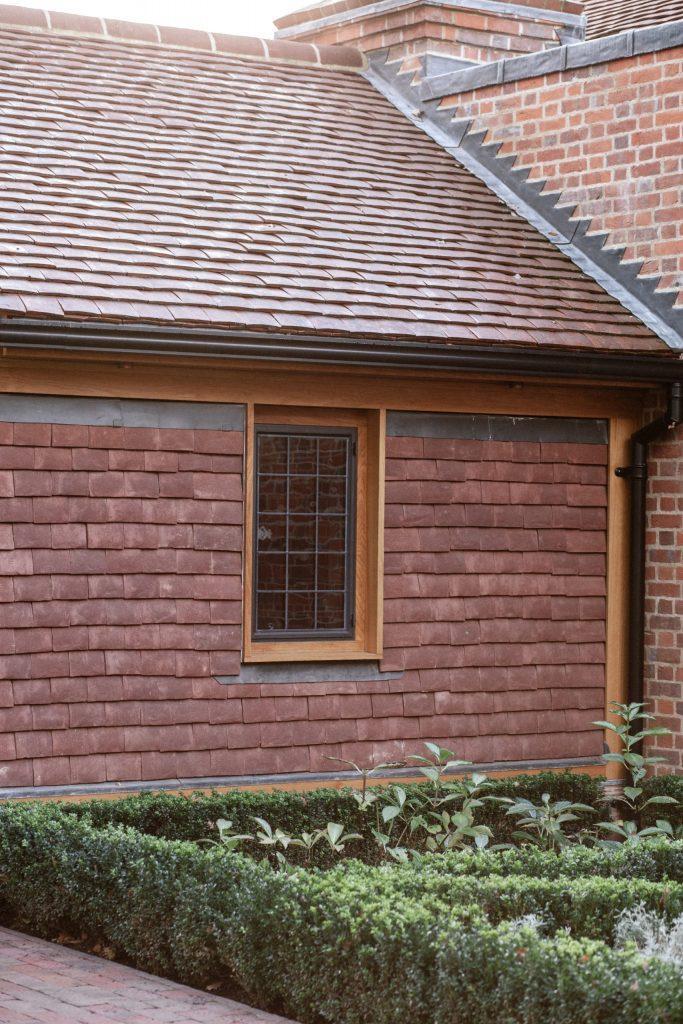
Vertically hung clay tiles cladding the walls
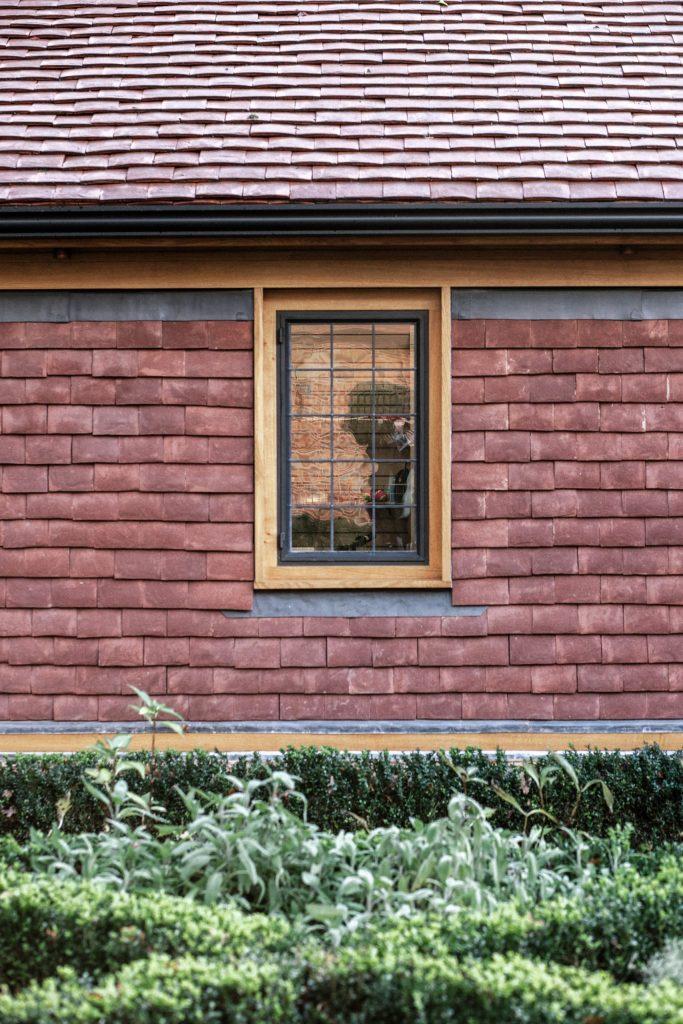
Oak framing around the windows
‘…..a feeling of warmth, character and joy as you pass through the cartway…..‘
We had trouble with the green oak that was used for the cartway to the coach house. Green oak is, quite frankly, still alive and when trying to develop details where it integrates with stonework and brickwork, proves very difficult as it constantly wants to move! It is also so strong that if it is tied to anything it will take the materials with it and cause no end of problems with cracking and movement. I am not against green oak and as you will see, we used it for the development of the woodland barn and other projects, but in the case of the stables we wanted to be secure with the detail of engineered oak, which also marries with the principals that we produced for the Summerhouse, Tennis Court Pavilion and later in the Gatehouse.
The cartway was constructed using a similar simplified version of the bladed truss that we had developed in the Summerhouse, with a high-level apex tie and a simple squared crown post supporting the ridge beam that in turn supports exposed rafters with sarking board over. It is a subtle detail that provides a feeling of warmth, character, and joy as you pass through the cartway to gain entrance to the service courtyard. The rear wall of the Summerhouse, with its lively brickwork and buff coloured mortar, provides the backdrop and whilst this is a relatively tall wall, with its higher parapet, it does not dominate the space and does not create the long deep cold shadows that we had expected to find, by placing another building directly behind it. A surprising and intimate space was instead found.
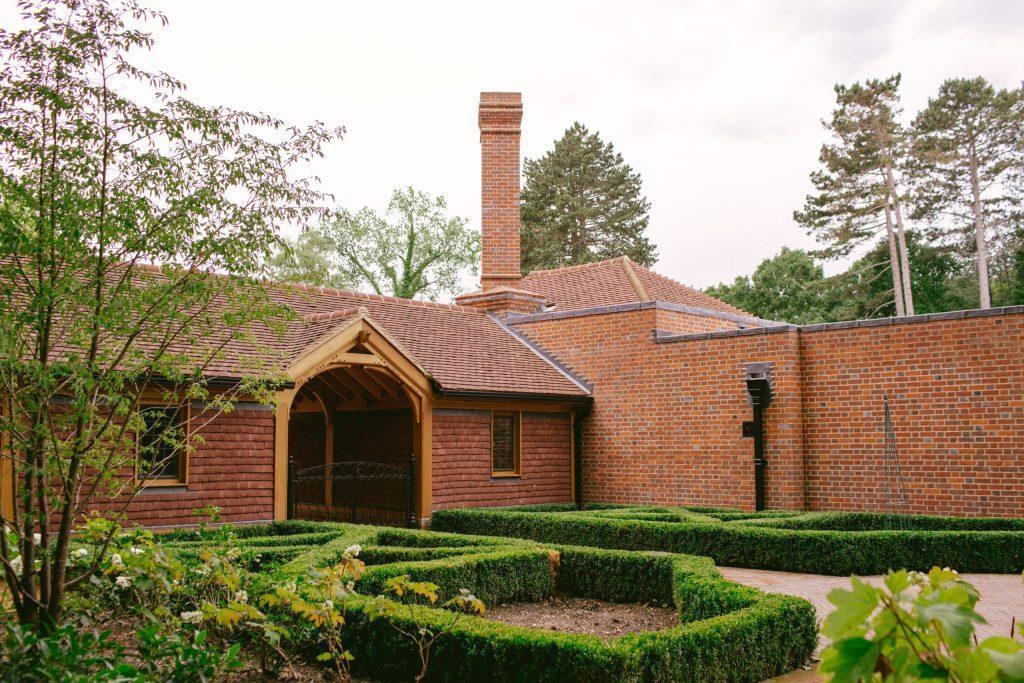
The Stable block behind the rear wall of the summerhouse
‘…a soft, homely character that relies almost entirely on the materials……‘
Whilst developing the designs of the Summerhouse, we had already designed the changing rooms to be included in the North wing of the stables, leaving the reast of the structure for storage. The building is quite simple, created using a brickwork plinthwith stone airbricks that were our creation across the site, and developed by using a water jet with hand carved details to finish, ensuring that each and every airbrick was subtly different in character. Above this, a lead detail separates an oak frame inset with vertically hung clay tiles, the same that we used for the roof. Rather than use brickwork, which I felt would have been overbearing in this small courtyard area, particularly with the rear wall of the Summerhouse in the same space, I decided to include the warm texture of vertically hung clay tiles that would allow the light passing from the South gardens to dance in between the undulating tiles and the nooks and crannies that they create. The whole thing was capped with a simple oak sprocketed roof, with oak barge boards to the verges on the gable ends and hogs-back tiles to the ridges. The result was a soft homely character that relies almost entirely on the materials to create a sense of warmth and comfort that we wanted to compliment the surrounding structures. The nature of this design was then reflected in the details for the woodland barn.
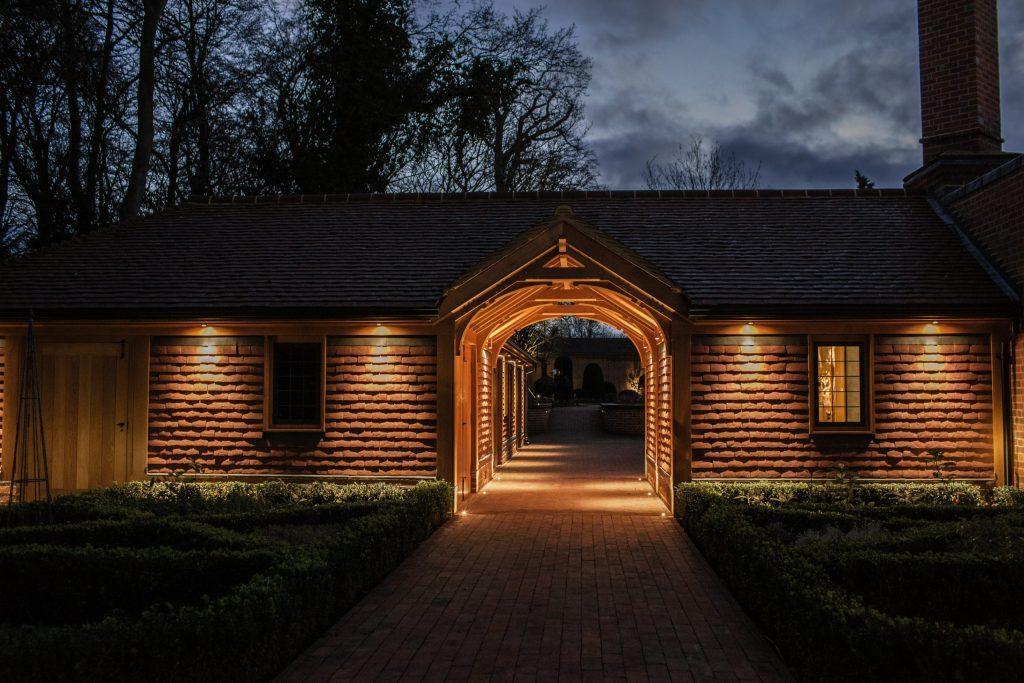
The cartway through the stables at night
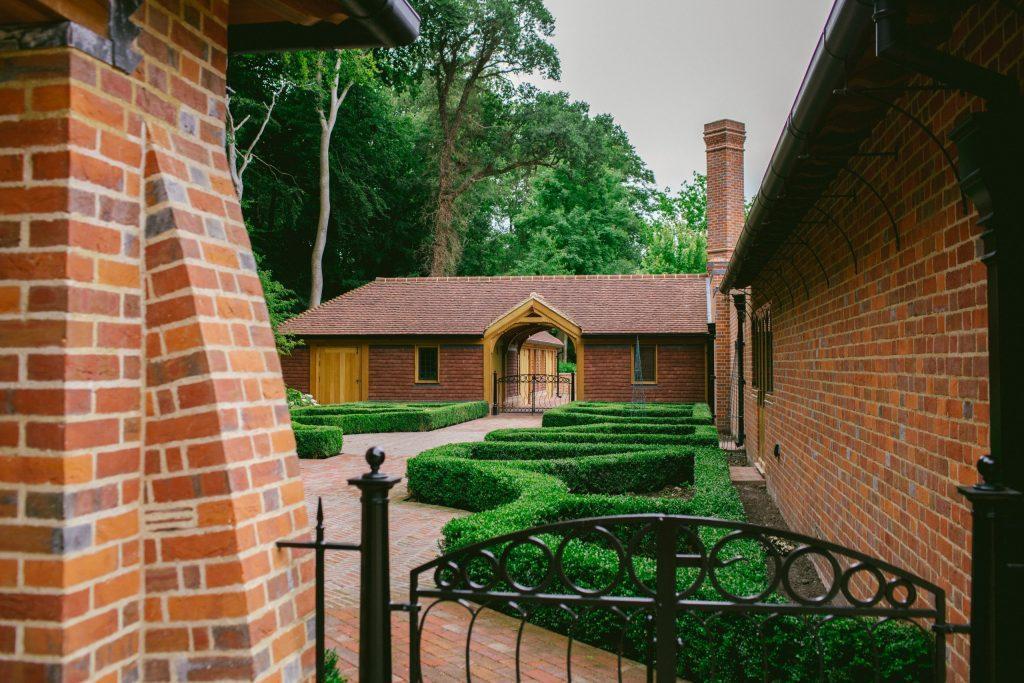
The stables and courtyard garden with bespoke gates by Jonathan Lees Architects
The Woodland Barn was designed as a maintenance structure to facilitate the management of the expansive beech woodland to the North of the property. This building is the first that you come across when entering the estate. It was constructed in a green oak frame by The Green Oak Frame Company and their skilled master craftsmen. As with the rest of the structures on the site, the oak beams are massive, and the king post trusses are things of elegant beauty. The rear and side walls are clad with the same vertically hung tiled detail with lead flashing as the stables, with the roof formed in the same Tudor clay roof tiles and spocketed eaves carrying half-round gutters. These gutters are supported on brackets connected to the oak sprockets. Oak doors, to match those of the garage, provide a taste of what is to come once the gatehouse is entered.
The Woodland Barn gave an opportunity to give a hint of the architectural treatment of the gatehouse, courtyard and main house without showing off too much, but again relying on the quality of materials and craftsmanship in construction to shine.
Return to the Writings Library for more essays and Project Profiles
